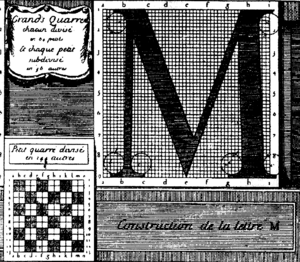Pierre Simon Fournier facts for kids
Pierre-Simon Fournier (born September 15, 1712 – died October 8, 1768) was a talented French artist and inventor from the 1700s. He was a punch-cutter, a typefounder, and a thinker about typography, which is the art of arranging type. Fournier collected and created many different types of letters.
His most important contributions to printing included designing beautiful letters, creating decorative starting letters (initials) and ornaments, and making a standard way to measure type sizes. He worked in the rococo style, which is known for its fancy and detailed designs. He created popular typefaces (fonts) like Fournier and Narcissus. Fournier was famous for adding decorative designs to his fonts. His biggest achievement was creating a standard measuring system that completely changed the printing world.
People also called him Fournier le Jeune ("the younger") to tell him apart from his father, Jean Claude, who also worked in printing. When he was young, Fournier learned to paint with watercolors and later learned wood engraving. In 1737, he wrote his first book about how much space should be between letters so they are easy to read.
Contents
Fournier's Career in Printing
In 1723, the French government decided that all printing types should follow certain rules. By 1737, Fournier decided to create his own type pieces using a new measuring system. Instead of just guessing the height, he used a specific scale of 6 ciceros or 72 points to one Paris inch. This was a big change because it made type sizes consistent.
Fournier's point system was a bit different from the Didot point system that came later. This was because Fournier used the Paris foot for his measurements, which was slightly shorter than the royal foot used by Didot.
Two years after he developed his new point system, Fournier decided to open his own company that made printing types, called a type foundry.
New Designs and Royal Connections
When France took over the Netherlands, King Louis XIV ordered new typefaces for his kingdom. The King kept these new fonts for himself, making it illegal for anyone else to copy them. Later, Fournier's book, Modèles des Caractères (published in 1742), continued this royal style but updated it for his own time. The fonts Fournier created had a very strong difference between thick and thin lines, which sometimes made them fragile.
When Fournier published Modèles des Caractères, it was full of rococo designs and decorative elements called fleurons. His book helped bring back the idea of using type ornaments, which had been popular in the 1500s. This led to other printers copying his style.
By the 1750s, Fournier was a very important person in the printing world. He advised countries like Sweden and Sardinia on how to set up their own royal printing presses. He also helped Madame de Pompadour, a powerful woman in the French court, create her own printing workshop.
Music and Printing
With his success, Fournier also got to explore his interest in music. In 1756, he worked with J. G. I. Breitkopf to create a new way to print music. This new style made musical notes look rounder, more elegant, and easier to read. It quickly became very popular. Before this, another printer named Ballard had a monopoly on printing music, using much simpler methods.
In 1762, Fournier received a patent for his invention. Surprisingly, other printers were not happy about this at first. They didn't think getting a patent for printing was right. Fournier then wrote a book about the history of cast iron characters for music. In it, he asked for his own work to be accepted, while also criticizing Ballard's older methods.
In 1764 and 1768, Fournier published his most important work, "Manuel Typographique." This book was a detailed guide to the history of French type and printing. It explained everything about making type, including his famous point system for measuring type.
Fournier's Legacy
Fournier's company continued to operate even after his death, staying open until the 1800s.
Interest in type design grew again in 1922 because of a book called Printing Types by D. B. Updike. This led to Stanley Morison, an advisor to the Monotype Corporation, starting a project to remake old fonts. One of the fonts they remade was Fournier's own self-named typeface.
Fournier's Thoughts on Other Typefaces
Fournier once said that John Baskerville's italic font was "the best found in any type-foundry in Europe." John Baskerville taught calligraphy (fancy handwriting) for four years before he started designing type. Both Fournier's and Baskerville's italic fonts were inspired by the style of copperplate engravings.
See also
 In Spanish: Pierre-Simon Fournier para niños
In Spanish: Pierre-Simon Fournier para niños



